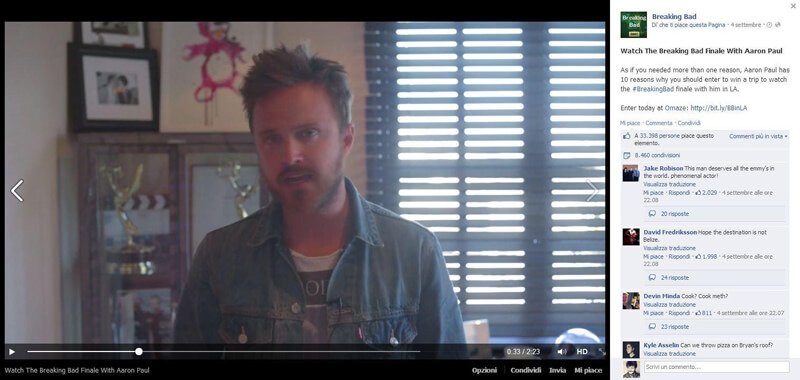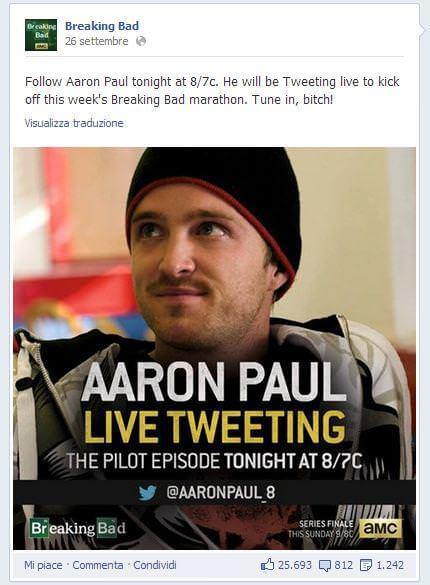As we well know, the main feature of Social Networks is interaction, in fact the moment two subjects interact, they simply exchange information, reinterpret it and react to it according to “a ‘mutual influence.
Once upon a time, communication was exclusively vertical: companies only placed themselves in the advertising perspective with a message imposed from above, television or billboards, in which the audience (customer or not) had in no way the opportunity to speak or respond directly to the message. With the advent of Social Networks, everything has completely changed, just think of the upheaval that is continually taking place in the entertainment industry, that is, a particular-but far from small-segment of the market that possesses the characteristic of having a very high number of engagement and interactions with its audience. This link between the Social, television and audiences effectively embodies the example we need to explain “horizontal communication.”
Breaking Bad and horizontal communication
When it comes to Breaking Bad, there is no need for explanation: it is simply the best product of the American culture industry in the last five years. Endorsements in regard to the actors, the direction and the production have come from all quarters: from Anthony Hopkins to Kevin Spacey to Jeffrey Katzenberg, CEO of Dreamworks, who offered $75 million to AMC in order to see at least three more episodes produced after the finale. In short, there was really a lot of hype around the world about this series. The metrics of success today are also measured by the ability to engage and interact on social networks, and Breaking Bad’s brand pages have done very well: they have fomented a spasmodic hype from episode to episode until the final one, while also ensuring that audiences can interact with the actors, ask questions, get answers, share content of various kinds and exchange opinions. The trump card that has allowed Breaking Bad to be so widely followed on social networks, beyond of course the very high quality of the series as such, has been the philosophy of approach with which the production approached these tools: as Brooke Ballard writes well on steamfeed.com, the communications team in charge of the series’ social evidently based everything on the motto “BEING social, not DOING social.” What Ballard means is that many companies, when they create their brand pages, are not at all interested in really creating horizontal communication or seeking true interactions with their users: they “do” a social campaign but do not really “be” social in the way that the production of Breaking Bad was.
Let’s take a couple of examples that can help better explain what I mean.
Interaction with Aaron Paul (Jesse Pinkman).
Analyzing the Facebook page during the airing of the series, one could find photos of Aaron Paul holding a sign with a date and time that read “I will be here for half an hour.” In that time frame, Aaron Paul would answer the most pointed questions from users, and he did not do so from the height of his authority as an actor, but he would “stoop to the level” of the audience, joking with them, using words such as “dude” or “bitch” that also recalled the language of his character. Unfortunately, these posts for some reason have been removed and can no longer be found for possible screenshotting or embedding.
However, some traces of this concept of interaction also remain in the video that also features Aaron Paul sponsoring the “viewing of the last episode in his company.” The video depicts him standing in what could be his home, talking very spontaneously and casually as if he were at the bar. Aaron is not in a large auditorium with a stage and a microphone to support him: the “amateur” dimension contrasts with the masterfulness of the series footage and “lowers” him to our level, toward “horizontal communication.” The same thing will be done with the “Live Tweeting” campaign during the marathon week that began on September 26: Aaron was connected and commented with users on the best moments of the pilot episode, always in the same language, never changing register and sincerely listening to fans’ opinions and observations. “Tune in, bitch!”
Being able to turn users into protagonists
Another great merit of the Breaking Bad communications team was that they made fans real stars of the page: retweeting, commenting, giving everyone space, they really created a very effective kind of engagement. Just look at this image posted at the Halloween party on Twitter and Facebook. The little boy is dressed up as Jesse Pinkman and his dog (wuao) as Walter White. The message is explicit and judging by the number of favorites and retweets it is definitely well received:
“Happy Halloween. Send us your #BreakingBad inspired costumes! #tbt.” (From our fan @inkjacket)
Obviously, the implicit promise is that the best “Breaking Bad”-themed costumes will be posted on the official page with a link to the authors’ profile: horizontality and user prominence returns.
This is “BEING” Social, and not “DOING” Social in an artificial, top-down and vertical way: many companies still haven’t understood this and approach new media in a completely “unhinged” way.
Yes agreed, but what were the results?
Let us examine the day of the season finale of Breaking Bad. On that day on social networks, not much was understood: the series completely dominated tweets and posts for 24 hours.
There was also a lot of confusion among analysts and social media specialists, in fact as reported by digitaltrend.com, the data initially were these: as meetions on twitter, #breakingbad received 373,337 (a quite impressive figure) of which 24.5 percent were positive and 59 percent negative. Such a high percentage of negative sentiment generated quite a few perplexities, but it must be considered that this data is detected by an automatic algorithm: it was concluded that the negative sentiment was not for “Breaking Bad,” but for the “end of Breaking Bad.” Basically, the reach of Breaking Bad on social media on that day was incalculable. On the day of the Emmys (the famous award show held every year in America), Breaking Bad not only won the top prize, but it also overwhelmed on social networks. In fact, according to Entertainment Weekly, the series had three times as many interactions and mentions as even the runner-up (not to mention then all the others). Breaking Bad is not only a stellar series, but it has also positioned itself well on Social by getting special attention, creating fans, interacting with them, listening to them: these have paid off in terms of loyalty and views, mentions and interactions that have brought benefits and satisfaction to AMC studios. The real relevant figure, however, has been the increase in audiences over the years: season by season the number of viewers has been steadily growing: part of the credit undoubtedly goes to the excellent campaign carried out on the various integrated communication platforms. I have used this case history to explain what I believe is a fundamental fact: we must not neglect the user, ever.
The user is what allows us to live, the reason why our company breathes and thrives, and it is to them that we must place our attention. Above all, our job must be to listen, and only then can we be the ones to speak up to wait for a new response.
This is exactly the philosophy with which it is necessary to approach Social Media.


